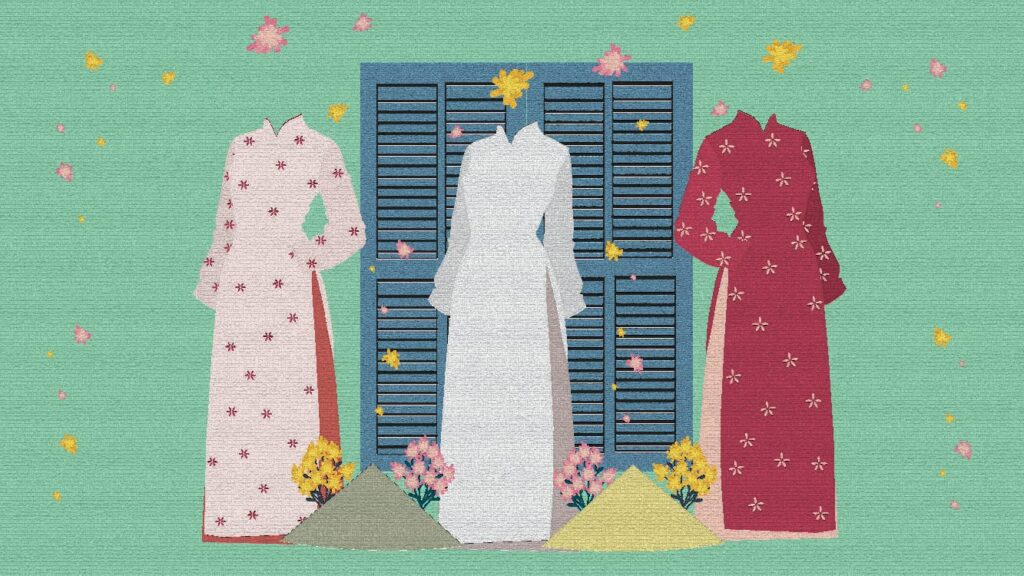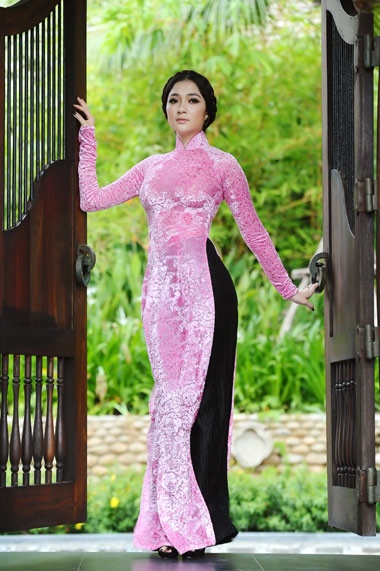
Vietnam – Trạch Xá, a village in Hanoi, is well-known for its custom-made áo dài, or long dresses that are traditional to Vietnam. The village’s skilled dressmakers have been essential to maintaining the traditional Vietnamese costume for generations. Village elders claim that Trạch Xá has been creating áo dài for over a millennium. Nguyễn Thị Sen, King Đinh Tiên Hoàng’s fourth wife, is said to have learned how to make dresses from seamstresses in the court. She taught the people the technique when she returned to her hometown of Trạch Xá. Since then, it has been passed down through generations and is still the main source of income for most people living in Trạch Xá.
Even though modern áo dài designs are widely available, Trạch Xá is home to several family-run businesses that continue to uphold the centuries-old national costume designs, such as the áo dài ngũ thân, or the customary long garment with five panels. Đỗ Minh Tám is one such designer who has brought the five-panel long garment back into vogue. Tám sews these traditional dresses with precise care in his small studio. Making lengthy gowns with five panels for many local female teachers is his current project.

According to Tám, the five-panel dress is unlike modern áo dài designs. Two pieces of fabric make up the front, two make up the back, and an inner one makes up the right chest of a five-panel dress. When fabric widths were 40 cm or less in the past, two pieces of cloth had to be sewn together to create a clothing body, said Tám.
The five-panel áo dài originally appeared at the Huế court of Lord Nguyễn Phúc Khoát in the middle of the 18th century. People from all socioeconomic classes wore it, therefore breaking societal boundaries. Over time, a more practical version of the ensemble became more popular and succeeded the five-panel áo dài. Fans of the five-panel garment, were satisfied with this as it gave men a unique posture and silhouette and ladies an elegant charm.
The long dress has a symbolic meaning as well. The wearer is represented by the inner panel, while the father, mother, father-in-law, and mother-in-law are symbolized by the four front and rear panels. The dress’s intricate hemstitching, which displayed flawless alignment and precise, subtle, and concealed thread lines, exemplifies the garment’s advanced sewing craftsmanship.

(Image courtesy of Cutemintran)
Even though Tám has an intense passion for traditional long clothing, he admitted that the modern áo dài style has taken over due to the growth of the market economy. Over a lengthy era of wars and economic hardship, the traditional long garment with five panels gradually disappeared. It became uncommon and overlooked, which caused a sharp drop in sales. The majority of Trạch Xá’s dressmakers were forced to alter their designs. Since innovative áo dài could be mass-produced in various designs and hues, it became increasingly challenging to maintain its original cultural significance as it changed yearly to suit personal preferences. Meanwhile, traditional áo dài stuck to just one style, and its cultural importance persisted, according
to Tám.
Due to the creativity and inventiveness of artisans like Tám, the long robe with five panels has found a new place in society. The five-panel long dress has gained popularity recently among young people who are eager to maintain traditional culture. The rise of associations, groups, and fan sites like Đình Làng Việt, Đại Việt Cổ Phong (Đại Việt Traditional Customs), and Việt Nam Cổ Phục Hội (The Vietnamese Traditional Costumes Association) is indicative of the dress’s revived popularity. The classic elegance of the five-flap long dress endures today, connecting the dots between history and contemporary thanks to the hard work of artisans like Tám. Its appeal has been revitalized by this comeback.
Trạch Xá is home to more than 500 houses, 90 percent of which are involved in the production of áo dài, according to Nguyễn Thị Dung, the deputy village leader. The art of tailoring is handed down through the generations; children as young as 8 or 10 are exposed to it, and by the time they are 15 or 16 years old, they are skilled sewing artisans.
Long dresses by Trạch Xá have been on display at various artisan shows throughout the nation. Additionally, the town is now recognized as a cultural icon by both domestic and foreign visitors. The Ministry of Culture designated Trạch Xá as a traditional dressmaking village in 2004. Presently, the community is seeking to be recognized as a national intangible cultural heritage for its skill.

The annual Ao Dai (Traditional Long Dress) Festival, organized by Hanoi Tourism, will establish the capital’s identity through cultural relevance and appreciation. According to Dang Huong Giang, head of the Hanoi Tourism Department, the objectives of the Hanoi Tourism Ao Dai Festival 2023 were to honor the traditional ao dai of the Vietnamese people The spouses of the ASEAN ambassadors in the US were commended by Nguyen Quoc Dung, the Vietnamese Ambassador to the US. He stated that the event honored Vietnamese women, increased solidarity and exchanges among the ASEAN diplomatic community, and promoted the unique cultural values of the ASEAN countries to friends and partners abroad.

The traditional long dress of Vietnam, according to Ambassador Dung’s wife Bich Van, is more than just a style of clothing; it symbolizes the identity and spirit of the Vietnamese people as well as the essence of Southeast Asian culture. Her goal was to have more chances to share the costumes and Vietnamese culture with friends from ASEAN, the US, and other countries.

About Author
Hi everyone! My name’s Elyonai Kristina Fanes, but in short you can call me Ely. Currently I am a writer at ASEAN Youth Organization – AYO Post. Actually, my hobbies are playing music, listening to music, and writing. I love to join music concerts and perform violin in front of many people.

About the Artist
Hello, she is Rana Fanindya Putri Murad, just call her Putri is one of the members of the multimedia team at AYO POST. A woman who loves graphic design and is delighted with the new knowledge she learns. In her free time, she likes to read books, try new recipes and do other fun activities.